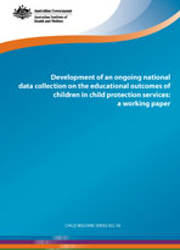Summary
Background
Improving the educational outcomes of children involved in statutory child protection services has been a high priority for Australian governments in recent years. The inclusion of education-specific national indicators in the National Framework for Protecting Australia's Children 2009-2020 and the National Standards for out-of-home care means the implementation of an ongoing national data collection on the educational outcomes of children in the care of the state has increased in importance and urgency. Such a collection would allow ongoing and longitudinal monitoring of academic progress, to better inform policy, practice and planning of activities to support these children.
This working paper sets out a proposed national methodology for reporting on the educational outcomes of children in child protection services. The former CDSMAC (now SCCDSAC) funded the AIHW to develop this methodology in collaboration with jurisdictions.
Proposed methodology
National reporting on the educational outcomes of children in care can be best achieved through linking the Child Protection National Minimum Data Set (CP NMDS) with a national set of education data (an 'Education Module', see Section 2). The CP NMDS is the 'base' data set for the Education Module and will be used to identify in-scope children.
In line with the National Standards for out-of-home care, the population scope of the Education Module would be children aged 0-17 years whose care arrangements have been ordered through the Children's Court, where parental responsibility for the child or young person has been transferred to the Minister/Chief Executive.
A range of relevant administrative data sets which capture information across the primary and secondary schooling years have been identified, from which data could be sourced for the Education Module (see Section 2 for details).
Undertaking data linkage at the national level will allow the use of nationally-consistent linkage processes to improve match rates and efficiency. The AIHW is a Commonwealth- accredited Data Integration Authority, and therefore well-positioned to undertake this linkage work for the Education Module.
A phased approach to implementation is recommended, commencing with linkage between NAPLAN data and CP NMDS data (Phase 1, further described in Section 3). The Education Module could then be expanded following the successful completion of Phase 1.
Phase 1 implementation
High-level support from both the child protection and education sectors will be required to implement the Education Module, which would involve national-level data linkage. In- principle support for the implementation of Phase 1 (further described in Section 3) was received from the appropriate national community services and education committees in early 2013-SCCDSAC, and the Australian Education, Early Childhood Development and Youth Affairs Senior Officials Committee (AEEYSOC). The AIHW has received funding from SCCDSAC to roll out Phase 1 over a period of 18 months, commencing in September 2013.



